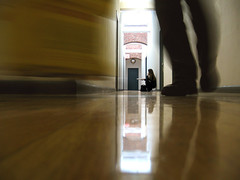
I Leica Edit 14
Originally uploaded by lorenzodom
This series of photos is an example of the Decisive Moments that I mention in the following musing mulling over the evening I took these photos outside the Leica Gallery in Manhattan.
Henri and His Leica
Tonight, Mia took me to a reception at the Leica Gallery on Broadway in Manhattan. Hosted by the Hungarian Consulate, the show celebrated the work of Erich Lessing and focused on his photos from 1956, in remembrance of the Anniversary of the Hungarian Revolution.
As you may already know, Oskar Barnack revolutionized photography with the invention of his small-format lightweight, 35 mm Leitz camera in 1914, offering unprecedented freedom to journalistic and artistic photographers. However, due to WWI the camera wasn’t introduced to the public for another ten years in 1924 as the first Leica.
One of the best-known and most-respected photographers of all time was Henri Cartier-Bresson, who, for practically 45 years, favored using the Leica camera for his work.
In my upcoming book, 25 Lessons (about photography; Cyan Books, Spring 2007) I elaborate a little on his work and technique. Following is an excerpt:
After I had settled in at the little church and was going out regularly into the city to take photos, I not only realized how pervasive beauty was, but I also realized that every once in a while I was able to capture these absolutely exquisite moments—moments when all the elements simply fell together and created a photo that was utterly a marvel to look at.
Eventually I would come to discover that my pursuit of this type of picture was quite akin to the art of a well known photographer by the name of Henri Cartier-Bresson, a Frenchman whose style eventually came to be known as one that captures “The Decisive Moment,” a term coined by Cardinal von Retz. The American publisher of Cartier-Bresson’s first English edition of his work, Dick Simon, used von Retz’s phrase as the title of Cartier-Bresson’s book (originally titled Images à la Sauvette), the first photodocumentary of decades of his work.
French poet Yves Bonnefoy aptly summarizes the magical quality of Bresson’s style in his description of his photograph Place de l’Europe in the Rain (1932): “How was he able to recognize the analogy between the man running across the plaza and the poster in the background so quickly, how could he compose a scene out of so many fleeting moments—a scene that is as perfect in detail as it is mysterious in its totality?”
Over the year following my stay at the Little Church I continued to hone my own style and art, and found that I too had a knack for capturing such decisive moments, especially as the occurred in the streets of New York City.
In retrospect, I also came to find out that Cartier-Bresson and I shared the same philosophy in regards to the equipment we used. The vast majority of his photos were taken via a 50mm lens, which is in a sense equivalent to the point-and-shoot I have used for all my photos.
This is especially true considering the much more powerful equipment that was eventually available to both us. Although fellow photographers and friends have encouraged me to upgrade to something like an “SLR,” I realized that these heavier, more conspicuous, much more expensive and higher-quality cameras were not suited to my off-the-cuff, hit-and-run, street style. Cartier-Bresson believed much the same thing as he felt that he needed to carry a minimal amount of equipment because it needed to serve him as a “sketchbook, an instrument of intuition and spontaneity, the master of the instant which, in visual terms, questions and decides simultaneously.”
With the aid of digital equipment though, I feel that I have been able to take this a step further by actually capturing a series of sequential “decisive moments,” in which I have documented a moment in time, much as someone might do with a video camera, but in a fashion that stops time, so that one can actually see how a moment evolves or tumbles or explodes with action, energy and color.
Oddly enough, a lot of people don’t see this though and complain that they do not understand why I post so many photos of the same thing.
“The same thing?” I often retort, if only to myself. To me, almost every photo has something new to offer that wasn’t in the previous or following shot—an emerging smile, a coincidental pairing of background and foreground elements, a sudden change in sunlight—all these things and so-so-so many more really do make each photo quite special to me.
Hence, despite the criticism I continued to post photos in this manner from one spring to another, until ultimately, after only a year on flickr I had posted more than 15,000 images.
*
Here is a set of examples of some of the special moments I have been able to capture with my little Power Shot, Canon A50, point-and-shoot: The Decisive Moment
Unfortunately, they did not serve goulash (I'm sure I misspelled that) or any tasty Hungarian pastries at the reception—just crusty old cheese bread and wine.
Nonetheless, the photos were interesting and the president of Leica was at the reception passing out their new the digital rangefinder LEICA M8 cameras for people to try.
lorenzo




No comments:
Post a Comment